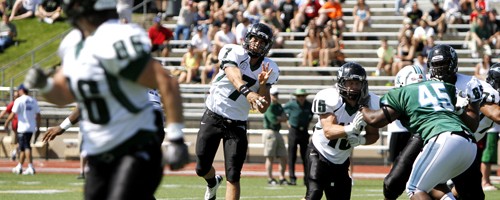Editor’s note: As we all know, the Portland International Film Festival is coming soon. What does that mean for us at the Vanguard?
Three easy pieces
[Editor’s note: As we all know, the Portland International Film Festival is coming soon. What does that mean for us at the Vanguard? Well, it apparently means a pound and a half of DVDs. This is also the first time I’ve ever had to sign for a package at the Vanguard. We’re going to do our best to bring you coverage of what you need to see at this year’s PIFF, and what you don’t really need to see.]
And Everything is Going Fine
“And Everything is Going Fine” (2010) is a documentary about the work of actor and monologist Spalding Gray. I’m not going to pretend I knew what a monologist was either. Basically, it’s a person who tells stories for a living, and they don’t even have to be funny. Yes, like that one professor you have that goes on tangents but with the actual job description.
Gray talks about a plethora of everyday topics, such as his mother’s dramatic prayer calls to Jesus, his attempts to join a writer’s colony and stories about the family cat. Gray’s tales, though random, calm and mediocre, are inexplicably captivating. The way his voice plays confidently with the words of his narration keeps audiences watching.
Gray is half the funny guy you sit next to, half the grandfather you never had. Admittedly, this film is not for everyone. Director Steven Soderbergh (“Ocean’s Eleven”) takes a rare approach to documentary filmmaking, simply producing a stream of raw footage from Gray’s monologues without any transitions, voice-over, or the like.
The film is as raw as it gets; nothing has been tampered with. I’m not sure if it’s really an approach as much as it is laziness. Maybe it’s just a time constraint thing. He would have added transitions if he wasn’t too busy planning his tearful retirement announcement that leaked via podcast just a few weeks ago.
The clips have no real order, some are in awful quality and I could have gotten an earful of stories from my blabbering relatives for free. However, if you are a habitual clip-hopper on YouTube and you regularly listen to unimportant people’s opinions, or read Facebook status updates of people you don’t know, you might find it rather enjoyable.
Snake in the Eagle’s Shadow
“Snake in the Eagle’s Shadow” (1978) is one of Jackie Chan’s first films, which is perhaps enough reason to view it. Chen Chi-Hwa directs this quirky kung fu flick, which follows classic themes of the genre including lots of awesome fighting, open set design, the juxtaposition of good and evil and orphan protagonism.
Unlike the Northwest Film Center’s recent showings of the Shaw Brothers films “The Avenging Eagle” and “Opium and the Kung Fu Master,” “Snake in the Eagle’s Shadow” lacks the overt comic element of the “fool” archetype. The film follows Chan’s character Chien Fu, an orphan who learns the ways of snake-style kung fu through his friendship with an old beggar played by Yuen Siu Tien. Chien Fu is put to the ultimate test when he comes face to face with the murderous Eagle Claw clan. Although action packed, “Snake in the Eagle’s Shadow” does not strive to compare to the Shaw Brothers productions with regard to set design appeal.
Bastard Swordsman
“Bastard Swordsman” (1983) is another Shaw Brothers film. This means that viewers can expect visually stimulating mise-èn-scene, serious cinematic zoom-ins, histrionic fight scenes and lots of drama. The film follows Yen, a regularly bullied orphan—that is, until he decides to battle the rival clan. Also, there is a swordsman involved, and he is quite the bastard. First impressions are shattered, relationships are questioned and discipline is rewarded in this whimsical film.



